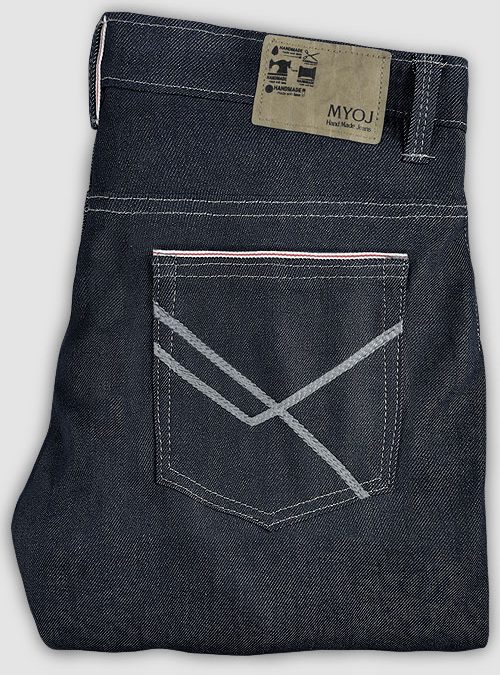When properly maintained, a pair of high-quality jeans can last a lifetime. Jeans are characterized by a denim construction. They aren’t made of wool, linen or other fabrics. Rather, they are made of denim. Some jeans, however, are made of a special type of denim known as raw denim. If you’re planning to buy a new pair of raw denim jeans, you’ll need to know how to care for them. Proper maintenance will allow you to get more use and value out of them.
What Are Raw Denim Jeans?
Raw denim jeans are trousers made of raw, unwashed denim. Denim is a warp-faced fabric consisting of cotton. It’s woven so that the weft goes under two or more warp threads. The end result is a strong cotton-based fabric with diagonal ribbing. With that said, denim can be either washed or raw.
Washed denim is submerged in water. After coming off the loom, washed denim is placed in a tub or bath of water. Raw denim, on the other hand, is not submerged in water. It’s immediately used to make jeans after coming off the loom.
Features of Raw Denim Jeans
Jeans made of raw denim typically have a darker color than those made of washed denim. Nearly all jeans are made of dyed denim. Denim consists of cotton. Cotton, of course, is white. Unless you’re planning to buy a pair of white jeans, they will probably be made of dyed denim. Raw denim jeans simply have a darker color than their washed counterparts.
Denim becomes lighter when washed. Washed denim jeans are made of water-soaked fabric, which causes some of the dye to leak out. The end result is a lighter tone. Raw denim jeans, conversely, are made of dry fabric. Raw denim is still dyed, but unlike washed denim, it’s not soaked in water. As a result, raw denim jeans tend to have a darker color.
Raw denim jeans also feel somewhat stiffer than washed denim jeans. This isn’t necessarily a bad thing. With their stiffer texture, raw denim jeans are naturally rugged. They won’t damage easily, nor will they quickly degrade.
Turn Inside Out When Washing
When washing your raw denim jeans, turn them inside out. You can turn them inside out by pulling the pant legs up through the center of the waistline. It only takes a minute to turn raw denim jeans inside out, but it can prove beneficial for several reasons.
By turning your raw denim jeans inside out, you’ll protect them from fading. Fading occurs when dye leaks out of the fabric from which a garment is made. Most of the dye is found on the exterior of jeans. Therefore, turning your raw denim jeans inside out will protect them from fading.
Turning your raw denim jeans inside out will also protect the other garments in your washing machine from bleeding colors. If dye leaks out of your raw denim jeans, it may bleed onto other garments. This can cause permanent discoloration. Fortunately, you can avoid this problem by turning your raw denim jeans inside out when washing them.

Use Cold Water
In addition to turning them outside, you should use cold water when washing your raw denim jeans. Some people assume that all garments, including raw denim jeans, should always be washed in hot water. The general belief is that hot water is more effective at removing stains than cold water. While hot water can, in fact, remove stains more effectively, cold water will typically suffice.
Washing your raw denim jeans in hot water is unnecessary. Exposure to hot water will only accelerate the fading process. Your raw denim jeans will fade more quickly when washed in hot water.
At the same time, hot water may cause them to shrink. Heat causes most fabrics to shrink — and denim is no exception. Washing your raw denim jeans in hot water day after day will eventually cause them to shrink. And if they shrink too much, you may not be able to wear them any longer. Rather than using hot water, wash your raw denim jeans in cold water. Cold water should offer more than enough stain-removing power while preserving the color and size of your raw denim jeans.
Cuff the Bottom
Another tip to make your raw denim jeans last is to cuff the bottom. The more you wear a pair of jeans, the greater the risk of damage to the bottom. The bottom of the pant legs may degrade to the point where they fray or rip. A simple solution is to cuff the bottom.
Cuffing the bottom means folding up a few inches of denim fabric at the bottom of the pant legs. Once cuffed, your raw denim jeans will essentially be shorter. They won’t extend all the way to the floor. Therefore, they’ll be better protected against damage. Failure to cuff the bottom may result in your raw denim jeans dragging on the floor when worn, which can lead to damage.
If cuffing the bottom sounds like too much work, you can choose a pair of selvedge raw denim jeans. Selvedge raw denim jeans are designed with permanent cuffs. More specifically, they are made on an old-style shuttle loom rather than a modern projectile-style loom.
Line-Dry Indoors
When your raw denim jeans are finished washing, consider line-drying them indoors. Line-drying involves hanging the jeans on a line to dry naturally. You can line-dry garments indoors or outdoors, the former of which is recommended for raw denim jeans. It takes longer than using a clothes dryer, but it offers a few advantages.
Line-drying your raw denim jeans indoors will protect them from heat. As previously mentioned, heat can cause them to fade and shrink. Hanging your raw denim jeans on a line to dry will only expose them to room-temperature air, thus protecting them from fading and shrinking.











